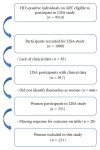Women's Health Care Utilization among Harder-to-Reach HIV-Infected Women ever on Antiretroviral Therapy in British Columbia
- PMID: 23227316
- PMCID: PMC3513717
- DOI: 10.1155/2012/560361
Women's Health Care Utilization among Harder-to-Reach HIV-Infected Women ever on Antiretroviral Therapy in British Columbia
Abstract
Background. HIV-infected women are disproportionately burdened by gynaecological complications, psychological disorders, and certain sexually transmitted infections that may not be adequately addressed by HIV-specific care. We estimate the prevalence and covariates of women's health care (WHC) utilization among harder-to-reach, treatment-experienced HIV-infected women in British Columbia (BC), Canada. Methods. We used survey data from 231 HIV-infected, treatment-experienced women enrolled in the Longitudinal Investigations into Supportive and Ancillary Health Services (LISA) study, which recruited harder-to-reach populations, including aboriginal people and individuals using injection drugs. Independent covariates of interest included sociodemographic, psychosocial, behavioural, individual health status, structural factors, and HIV clinical variables. Logistic regression was used to generate adjusted estimates of associations between use of WHC and covariates of interest. Results. Overall, 77% of women reported regularly utilizing WHC. WHC utilization varied significantly by region of residence (P value <0.01). In addition, women with lower annual income (AOR (95% CI) = 0.14 (0.04-0.54)), who used illicit drugs (AOR (95% CI) = 0.42 (0.19-0.92)) and who had lower provider trust (AOR (95% CI) = 0.97 (0.95-0.99)), were significantly less likely to report using WHC. Conclusion. A health service gap exists along geographical and social axes for harder-to-reach HIV-infected women in BC. Women-centered WHC and HIV-specific care should be streamlined and integrated to better address women's holistic health.
Figures
References
-
- UNAIDS. Global report: UNAIDS report on the global AIDS epidemic 2010. UNAIDS/10.11E |JC1958E, 2010.
-
- PHAC. HIV and AIDS in Canada—Surveillance Report to December 31, 2009. 2010, HP37-2/2009.
-
- Tsasis P. HIV/AIDS challenges the normative model of healthcare delivery in Canada. Health Services Management Research. 2001;14(1):55–61. - PubMed
-
- Church K, Lewin S. Delivering integrated hiv services: time for a client-centred approach to meet the sexual and reproductive health needs of people living with hiv? AIDS. 2010;24(2):189–193. - PubMed
LinkOut - more resources
Full Text Sources
Miscellaneous


